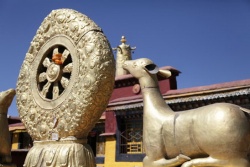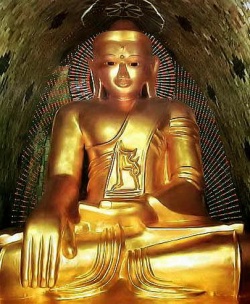The Spiritual Realm of the Two Vehicles - The Noble and Selfless Life
The Two Vehicles are defined as follows:
Mode of Learning |
Quality Used |
Minimum Capacity Needed | |||
Hearing from another |
Dull | ||||
Spiritual Self-Awakening |
Considering for oneself |
Sharp |
1. Sravakas: Literally ‘hearers of the voice’ - disciples - students of the spiritual path. This term was a title first used for the original disciples of the Buddha, those who actually heard the words that came from the Buddha’s lips. Sariputra and Maudgalyayana were considered the Agra-Sravakas or Chief Disciples whereas the others disciples were called The Maha-Sravakas (Great Disciples). The term was later used for disciples of the Buddhist spiritual path that learned directly from a teacher (through a lineage) and strived for the ideal of becoming an Arhat (literally, a ‘worthy’, that is, one worthy of alms). Sometimes this term is used to denote students of The Four Truths, the first teaching of the Buddha.
2. Pratyekabuddhas: Literally ‘lone’ or ‘solitary Buddhas’ - those that have attained spiritual enlightenment for themselves but have not helped others to become spiritually awakened. This was a term used for those that sought and found enlightenment by and for themselves, without help from the Buddha or one from his lineage. Lacking sufficient compassion, they did not share their awakening with others. Originally this was a term used to describe the Jains, followers of Mahavira. Sometime later this term was used to distinguish those that had mastered of The Twelve-fold Wheel of Causality and Conditions, since the historical Sakyamuni originally taught the four truths and the fully elaborated teaching of the twelve-fold wheel may have come later.
Laying down the burden of this world, the aspirant practices the 37 Facets of Spirituality and attains the Four Fruits of the Arhat. The Arhat lives a holy life and is master of the self (ego). He is pure of heart, with no need for anything or anyone. An Arhat who is so liberated will not be reborn into the threefold realm.
The Buddha, out of compassion for living beings, urged disciples and Arhats to follow His example and teach of the Dharma to other living beings so that they may attain liberation as well. In the early monastic order they did so. However, as the decades and centuries passed after the Buddha’s final Nirvana, the monks began to emphasize certain duties and neglect others. Many tended to become self-centered and too focused on their own salvation, losing their diligence in spreading the Dharma to others. Many in the monastic order became indolent and spiritually selfish, despite their outward saintliness and serenity. This led to the development of a new ideal, that of the Bodhisattva, who defers liberation and remains in the threefold realm out of compassion to lead fellow living beings to salvation. Now, in making the distinction between the Bodhisattva and the Two Vehicles, the latter are said to be only concerned with their own spiritual benefit.

